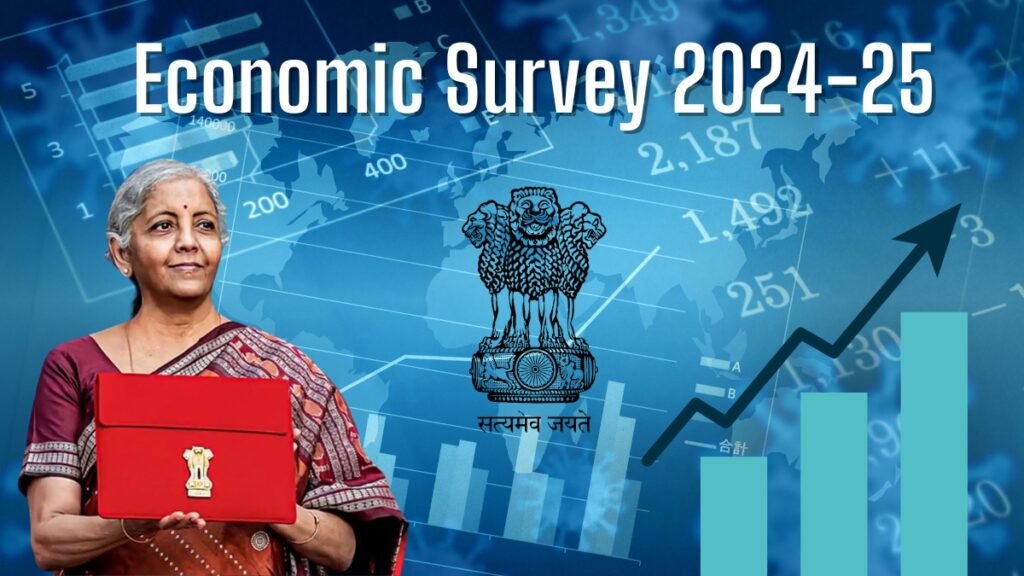The Economic Survey of India 2024-2025, presented by the Ministry of Finance, provides a comprehensive assessment of the nation’s economic performance over the past year and outlines key policy measures and future projections. This year’s survey emphasizes economic stability, growth resilience, and structural reforms, while also addressing challenges related to inflation, infrastructure, foreign investments, and financial sector regulations.
State of the Economy
- India’s GDP growth for FY25 is projected at 6.4%, with strong contributions from agriculture, services, and manufacturing.
- Despite global uncertainties, domestic demand remains robust, supported by increased government spending and private sector investments.
- Fiscal consolidation remains a priority, with the government aiming to keep the fiscal deficit under 4.5% of GDP.
- Employment trends indicate steady growth, with significant contributions from services and digital sectors.
Monetary and Financial Sector Developments
- The Reserve Bank of India (RBI) maintained a stable repo rate at 6.5% to balance inflation control and growth stimulation.
- Bank credit growth showed steady improvement, with rising demand from MSMEs and large corporates.
- The capital markets performed well, with Indian stock indices reaching new highs, supported by strong domestic institutional investments.
- The financial inclusion index improved, highlighting progress in digital banking adoption and rural financial services.
External Sector and Trade
- Foreign Direct Investment (FDI) inflows increased by 17.9% YoY, reflecting investor confidence.
- India’s exports and imports remained stable despite global trade disruptions, with a focus on enhancing ease of doing business for exporters.
- The foreign exchange reserves stood at $640.3 billion, ensuring strong external sector stability.
- The government aims to diversify export markets, focusing on technology-driven industries like semiconductors and renewable energy.
Inflation and Price Trends
- Retail inflation averaged 4.8%, with food inflation remaining a key concern.
- Government measures to curb food inflation included stock limits, subsidies, and duty-free imports of essential food items.
- Commodity prices are expected to decline in 2025, easing input costs for businesses and consumers.
Investment and Infrastructure Development
- The government increased capital expenditure on infrastructure by 38.8% over the past five years.
- Public-private partnerships (PPP) are being encouraged to attract private investment in transport, energy, and urban development.
- Major infrastructure projects include railway expansion, smart cities, and renewable energy initiatives.
- Tourism and space infrastructure also saw significant investments to boost economic diversification.
Industry and Services Sector Performance
- Manufacturing and core industries showed resilience, driven by reforms in labour laws and production-linked incentive (PLI) schemes.
- The service sector remains the largest contributor to GDP, with growth in IT, fintech, healthcare, and logistics.
- Startups and MSMEs received policy support through credit guarantees and easier regulatory compliance.
Agriculture and Food Management
- Kharif food grain production is expected to increase by 5.7%, ensuring food security.
- The government continues to support farmers with subsidies, minimum support prices (MSP), and irrigation projects.
- Sustainable agriculture practices are being promoted to tackle climate change impacts on crop yields.
Future Economic Outlook
- The Indian economy is expected to remain resilient, with growth projected at 6.4%–6.6% over the next two years.
- Structural reforms in taxation, digital economy, and labor laws will continue to drive economic expansion.
- The government is focusing on green energy, AI, and digital transformation to boost long-term competitiveness.
- Global risks, including geopolitical tensions and commodity price fluctuations, may impact economic stability, requiring agile policy responses.
Conclusion
The Economic Survey 2024-25 highlights India’s strong macroeconomic fundamentals, resilience against global uncertainties, and strategic focus on investment-led growth. With continued policy reforms and government initiatives, the Indian economy is poised for sustained expansion, enhanced infrastructure, and increased global trade integration in the coming years.
